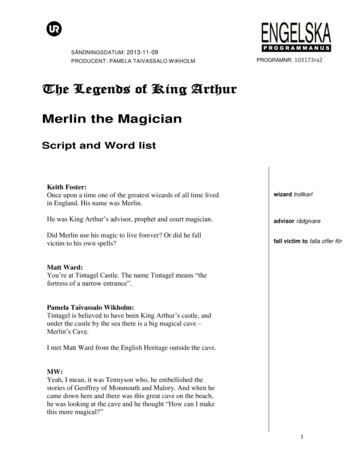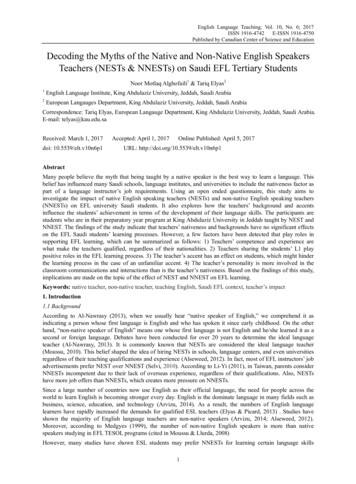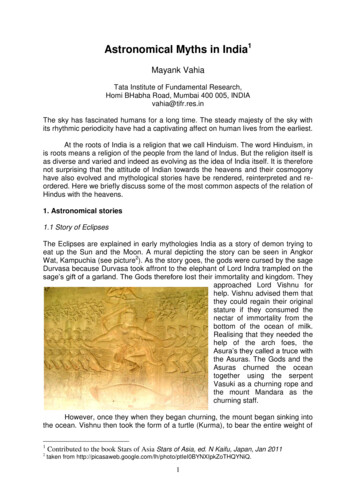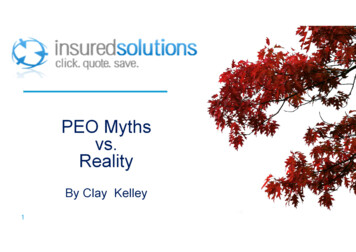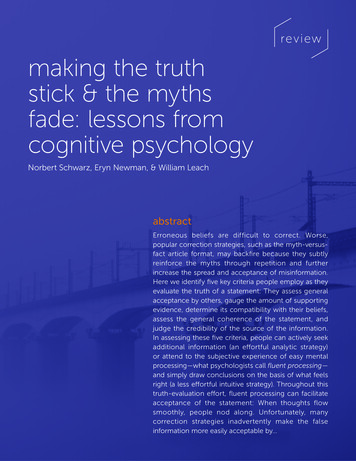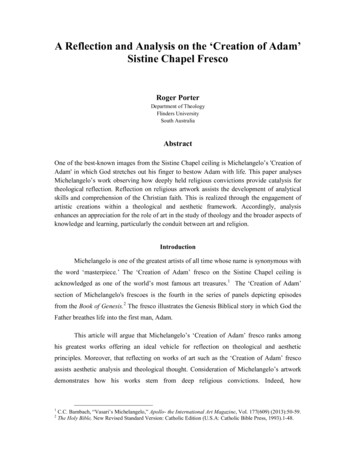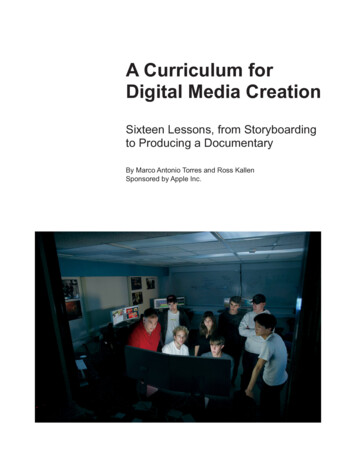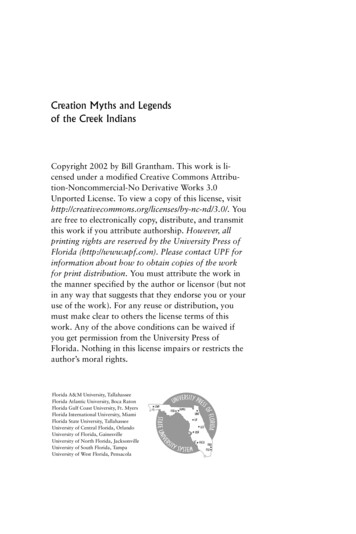
Transcription
Creation Myths and Legendsof the Creek IndiansCopyright 2002 by Bill Grantham. This work is licensed under a modified Creative Commons Attribution-Noncommercial-No Derivative Works 3.0Unported License. To view a copy of this license, 3.0/. Youare free to electronically copy, distribute, and transmitthis work if you attribute authorship. However, allprinting rights are reserved by the University Press ofFlorida (http://www.upf.com). Please contact UPF forinformation about how to obtain copies of the workfor print distribution. You must attribute the work inthe manner specified by the author or licensor (but notin any way that suggests that they endorse you or youruse of the work). For any reuse or distribution, youmust make clear to others the license terms of thiswork. Any of the above conditions can be waived ifyou get permission from the University Press ofFlorida. Nothing in this license impairs or restricts theauthor’s moral rights.Florida A&M University, TallahasseeFlorida Atlantic University, Boca RatonFlorida Gulf Coast University, Ft. MyersFlorida International University, MiamiFlorida State University, TallahasseeUniversity of Central Florida, OrlandoUniversity of Florida, GainesvilleUniversity of North Florida, JacksonvilleUniversity of South Florida, TampaUniversity of West Florida, Pensacola
This page intentionally left blank
Creation Myths and Legendsof the Creek IndiansBill GranthamUniversity Press of FloridaGainesville · Tallahassee · Tampa · Boca RatonPensacola · Orlando · Miami · Jacksonville · Ft. Myers
Copyright 2002 by Bill GranthamPrinted in the U.S.A. on acid-free, TCF (totally chlorine-free) paperAll rights reserved07 06 05 04 03 026 5 4 3 2 1Library of Congress Cataloging-in-Publication DataGrantham, Bill.Creation myths and legends of the Creek Indians / Bill Grantham.p. cm.Includes bibliographical references and index.ISBN 0-8130-2451-X (cloth: alk. paper)1. Creek mythology. 2. Creek Indians—Folklore. 3. Legends—Southern States.I. Title.E99.C9 G68 2002398.2’089’973—dc21 2001041580The University Press of Florida is the scholarly publishing agency for the StateUniversity System of Florida, comprising Florida A&M University, Florida AtlanticUniversity, Florida Gulf Coast University, Florida International University, FloridaState University, University of Central Florida, University of Florida, University ofNorth Florida, University of South Florida, and University of West Florida.University Press of Florida15 Northwest 15th StreetGainesville, FL 32611–2079http://www.upf.com
In memory of William Jefferson Grantham, Jr., 1934–1999
This page intentionally left blank
ContentsPreface ixAcknowledgments xiPart I. Beliefs and Ritual1. The Role of Mythology 32. Cosmogony 143. Creek Cosmology 214. Souls 385. Spiritual Specialists 456. Miscellaneous Beliefs 507. Sacred Plants or Medicines 558. Sacred Time and Space 639. Ceremony and Ritual 6810. Conclusions 83Part II. Myths and Legends11. Earth Diver Myths 8912. Emergence Myths 10613. Migration Legends 13414. Relationships Between the Tribes 15915. Journeys into the Sky World 16716. Visitors from the Sky World 18817. Snake Man Legends 19918. Man-Eating Birds 22819. Tobacco and Corn: Sacred Plants to the Creeks 23520. Contemporary Creek Myths and Legends 254Appendix of Sources 277Phonetic Guides 285Glossary of Creek Words 289Glossary of Geographical Locations 295
Notes 301Bibliography 313List of Stories by Author 319List of Stories by Cultural Group 323Index 327
PrefaceIn my own search for an understanding of Creek mythology and cosmology, I realized that no single work existed that encompassed the entirecorpus of information available. The myths and legends collected herewere published in ethnographies, magazines, travelers’ accounts, and avariety of other formats, many of which have become obscure. This workbrings together for the first time an extensive collection of Creek creationmyths and migration legends in a format that allows the reader to compare the myths and legends and to retrieve information from them easily.It is my hope that historians, anthropologists, folklorists, and students ofreligion will find this work a useful reference and that people of Creekdescent will find it an accurate repository of their myths, legends, andreligious heritage.
This page intentionally left blank
AcknowledgmentsI would like to thank several people who made this work possible. CharlesDaniels (Sakim) generously provided me with many references and, alongwith Mary Johns, some of the contemporary Creek myths that are included here. Daniel Penton provided insight and in-depth discussion ofmany of the myths and concepts presented. Donna Cobb graciously provided the cover design. Daniel Penton, Dr. Robert Pullen, Donna Cobb,and my father, William J. Grantham Jr., read early drafts of the work andoffered many useful suggestions for improvement. I thank my wife, Susan,for her support and help in preparing the final manuscript. And finally, Iwould like to thank the many people who offered their encouragementand enthusiastic support for the project.The following institutions have given their permission to use material heldunder copyright:Encino Press for Howard N. Martin, Myths and Folktales of the AlabamaCoushatta Indians of Texas (Austin, 1977), pp. 2–3, 67–70, 84–85.The Georgia Historical Society for Benjamin Hawkins, A Sketch of theCreek Country, in the years 1798 and 1799. And Letters of BenjaminHawkins 1796–1806. Spartanburg, S.C.: The Reprint Company, 1982.From the Collections of the Georgia Historical Society, vol. 3, part 1,pp. 81–83.The Oklahoma Historical Society for two articles from The Chronicles ofOklahoma: Anna Lewis, “Nunih Waiya,” vol. 16 (1938): 214–20, andRev. J. J. Methvin, “Legend of the Tie-Snakes,” vol. 5 (1927): 391–96.The Texas Folklore Society for two articles in Straight Texas (1937), edited by J. Frank Dobie and Mody C. Boatright, Texas Folklore SocietyPublications no. 13: G. T. Bludworth, “How the Alabamas CameSouthward,” pp. 298–99, and Frances Densmore, “The Alabama Indians and Their Music,” pp. 276–77.
xii AcknowledgmentsThe University of Georgia Press for Shem, Ham and Japheth: The Papersof W. O. Tuggle (Athens, 1973), pp. 173–74, 175–76. Reprinted asShem, Ham, and Japheth: The Papers of W. O. Tuggle Comprising HisIndian Diary Sketches and Observations, Myths and Washington Journal in the Territory and at the Capital, 1879–1882, edited by EugeneCurrent-Garcia with Dorothy B. Hatfield. Ann Arbor, University Microfilms International, 1989.
Part IBeliefs and Ritual
This page intentionally left blank
1The Role of MythologyTheir medicine has no strength anymore to help them. The Indian has lost all his knowledge. And so their medicine and theirpleasure are all different now. The life ruler had given them allthese things for their use but they did not take care of them. Themedicine that they have now and their clothing is all different,they wear clothes of the “water-foam-people”; their own dressesare lost, their own way of thinking has been lost, and they do notknow any more what the old people have taught.These words, recorded during the summer of 1928 and the winter of1929, were spoken by Maxey Simms about his own people, the Yuchi.1While it is perhaps true that much of “what the old people have taught” isforgotten, it is not all lost. Some of the mythological stories describing thecreation of the worlds and the earliest times of the Creek Indians who oncepopulated southeastern North America are still to be found scatteredthrough obscure academic journals and among the descendants of thoseearliest Creek people.Mythology and ReligionUnfortunately, a negative connotation is often attached to the term myth.Myths are commonly seen as untrue or fanciful explanations of the past.E. B. Tylor viewed myths as logical associations of ideas that account fornature with the aid of analogies and comparisons.2 Often confused withfolktales, which are flighty, fantastic, and migratory, and with legends,which are locally bound and historically rooted, the myth portrays godsand supernatural beings and all kinds of metamorphoses.3 Myths revealthe world of the gods and the cosmic order through which the social orderand cultural values of a society are confirmed.4
4 Part I. Beliefs and RitualSome of the earliest treatments of North American mythology are credited to D. G. Brinton, who focused on the solar aspects of North Americanmyths, and to H. Kunike, who focused on lunar themes.5 During the earlypart of this century, Franz Boas in anthropology and Krohn in folkloretook a historico-geographic approach to North American mythology.Boas’s Tsimshian Mythology and Gladys Reichard’s An Analysis of Coeurd’Alene Myths provide examples of Boas’s diffusionist influence, whileStith Thompson’s work provides examples of Krohn’s influence.6 It wasalso during the early part of the twentieth century that John R. Swantonurged scholars to compile a concordance of North American myths, andthe concepts of “tale type” and “motif index” began to be applied toNorth American myths.7During the 1930s and 1940s, Bronislaw Malinowski’s functionalismgreatly influenced the study of mythology in other parts of the world, but,because of Boas’s considerable influence, it had little impact in NorthAmerica. During the same period, some European scholars began taking apsychoanalytic approach to mythology, and much of their attention wasturned toward North American myths. The “culture hero” and “trickster,” common characters in North American legends and folktales, attracted the interest of such scholars as Geza Róheim and Carl Jung.8 In thisanalytic approach to mythology, irrational man, particularly his id andsublimations, provides the central focus. Similarly, Sigmund Freud soughtthe origins of mythology in the subjects and images that occurred indreams.9 Religion, in his approach, is considered only as an expression ofsubconscious forces at work.During midcentury, a sociological approach to mythology emerged inEurope. In Britain, Robertson Smith began considering mythology as adescription of ritual, while Emile Durkeim, in France, reached the conclusion that religion, including myth, is modeled on and integrated with society. A. R. Radcliffe-Brown and his pupils also adopted Durkheim’s approach in Britain.10 Both approaches have been criticized for their lack ofconsideration of the religious aspects of myths and for their reductionism.The sociological approach has, however, shown that myth can serve as acharta—a sanction—for both ritual and profane institutions.11An analytic approach that has had considerable influence in the studyof North American mythology is the structuralist approach of ClaudeLévi-Strauss.12 The structuralists’ focus, however, is not on the mythsthemselves but on the structure of the human mind that produces themyths. In this approach the way that elements of a myth are combined aretaken as coded messages, which, if analyzed properly, provide clues as to
The Role of Mythology 5the structure of the mind.13 Little or no attention is paid to the religiousaspects of mythology, but the structuralist approach does point out thelogic, rhythm, and style of a myth.14Myth and Religion: Sacred Time and SpaceThe role of myth in religious belief systems and daily life is an importantone. Unfortunately, scholars have paid little attention to the relationshipbetween mythology and religion. Myths are considered the most sacredtruths to those among whom the myths originate. Myths are a culture’sway of explaining how the world, people, and all things came to exist, andhow order or cosmos was established from disorder or chaos. Since theevents of a myth take place at the beginning of the world or universe as itis now known, they are necessarily intricately concerned with time. Time,according to Mircea Eliade, exists in two forms, sacred and profane: “Onthe one hand there are the intervals of a sacred time, the time of festivals(by far the greater part of which are periodical); on the other is profanetime, ordinary temporal duration, in which acts without religious meaning have their setting.”15 Profane time—ordinary temporal duration—passes, never to be reclaimed. Sacred time, however, is the time in whichcosmos is brought from chaos; that is, order is brought from disorder,existences from non-existence, the world from nothingness. It is the timeof the original creation, a time when the gods were active in the formationand ordering of the universe. Sacred time is reclaimable, repeatable; “byits very nature sacred time is reversible in the sense that, properly speaking, it is a primordial mythical time made present.”16 By means of ritual,rites, and religious festivals, sacred time can be experienced by ordinarybeings: “Every religious festival, any liturgical time, represents the reactualization of a sacred event that took place in a mythical past, ‘in thebeginning.’ Religious participation in a festival implies emerging fromordinary temporal duration and reintegration of the mythical timereactualized by the festival itself.”17Sacred history (myth) supplies the models for the rituals, rites, andfestivals in which ordinary beings should engage in order to reclaim sacredtime: “Origin myths provide answers to questions about how things began; equally important, they also serve to establish an order among valuesand to justify, by reference to these values, the major customs and institutions of society. Furthermore, the myths, being biographies of the gods,endow the names of the pantheon not only with a list of powers andattributes but also with unique personal identities comparable to those of
6 Part I. Beliefs and Ritualreal human beings. The myths, in other words, describe the supernaturalcommunity with which man must interact.”18 More directly, Eliade argues:The myth reveals absolute sacrality, because it relates the creativeactivity of the gods, unveils the sacredness of their work. In otherwords, the myth describes the various and sometimes dramatic irruptions of the sacred in the world.[T]he supreme function of the myth is to “fix” the paradigmaticmodels for all rites and all significant human activities—eating,sexuality, work, education, and so on. Acting as a fully responsiblehuman being, man imitates the paradigmatic gestures of the gods,repeats their actions, whether in the case of a simple physiologicalfunction such as eating, or of a social, economic, cultural, military,or other activity.19The repetition or the reenactment of divine models provided by themyths is an act of imitation of the gods, through which man remainssacred. Also, through the continuous reactualization of these divine models, the world is resanctified. “Men’s religious behavior contributes tomaintaining the sanctity of the world.”20Especially important among mythological traditions is the cosmogony—the original act of creation, the emergence of cosmos fromchaos—which Eliade describes as “the supreme divine manifestation, theparadigmatic act of strength, super abundance, and creativity.”21 Hereinlies an important motivational force. Ritual, or the reenactment of myth,is at the same time a repetition of a past divine activity and a new creativeaction:Through annual repetition of the cosmogony, time was regenerated,that is, it began again as sacred time, for it coincided with the illudtempus in which the world had first come into existence. . . .[B]y participating ritually in the end of the world and its re-creation, any man can become contemporary with the illud tempus;hence he was born anew, he began life over again with his reserve ofvital forces intact, as it was at the moment of his birth.22Many cultures view sacred or cosmic time as cyclic. It begins, ends, andbegins again. This concept is more comprehendible when it is understoodthat time itself only came into existence with the original creative act; thus,the reactualization of the divine creative activities recounted in myth, ineffect, restarts the cosmic cycle. To some cultures time and cosmos are so
The Role of Mythology 7intertwined that they are considered synonymous. According to Eliade, insome North American Indian languages the concept of the world or cosmos is used in the same sense as the concept of a year; as the temporal yearends, so too does the cosmos return to chaos.23Through the annual reactualization, or ritual reenactment of the mythical original creation, cosmos is returned from chaos and sacred time begins anew. All that is old is made new again, sins and transgression of thepast year are dissolved, and man too, having symbolically participated inthe cosmogony or original creation of the world, is regenerated, bornagain in a purer form.Equally as important as the concept of sacred time is the concept ofsacred space. As Eliade states, “For religious man, space is not homogeneous; he experiences interruptions, breaks in it; some parts of space arequalitatively different from others.”24 The concept of sacred space is ofprimary importance to all religious traditions for “if the world is to belived in, it must be founded,” and no world can be founded in the chaos ofprofane space.25 Most cultures, especially nonindustrialized ones, perceivethe world in terms of three levels or planes: an upper world, the middleworld (earth), and the lower world. Sacred space, any space where thesacred manifests itself on earth, can be thought of as an axis mundi: thecenter of the world. It is this world axis that provides the orientation forthe world and connects the three planes. This axis, providing an openingthrough the three planes, makes possible communication with the sacred.This world axis may be symbolically represented as a world pillar, a ladder, a cosmic mountain, a cosmic tree, and so forth. Eliade provides asequence of concepts and cosmological images that together constitutewhat he calls the system of the world:(a) A sacred place constitutes a break in the homogeneity of space.(b) This break is symbolized by an opening by which passage fromone cosmic region to another is made possible (from heaven to earthand vice versa; from earth to the underworld).(c) Communication with heaven is expressed by one or another certain images, all of which refer to the axis mundi: [world] pillar, ladder, [cosmic] mountain, [cosmic] tree, [cosmic] vine, etc.(d) Around this cosmic axis lies the world . . . hence the axis islocated “in the middle,” at the “navel of the earth”; it is the center ofthe World.26Within the boundaries of sacred space, the profane world is transcended and communication with the gods is made possible; it is the place
8 Part I. Beliefs and Ritualwhere the gods can descend to earth and man can symbolically ascend tothe world of the gods.Whatever boundaries religious man perceives as his world, whethercountry, city, village, or house, he has a need to exist in an organized worldor cosmos. To achieve this organized world, he seeks orientation withrespect to the axis mundi through the ritual provocation of signs indicating the location of sacred space. Once determined, the axis or center of theworld becomes the point of orientation from which man’s sacred places,and in fact his whole world, are constructed. Construction itself, becauseof the orientation provided by sacred space, then becomes a sacred act, areenactment of the original world creation.27Historical Sketch of the CreeksTo understand Creek cosmological and mythological beliefs, it is necessary to understand the historical context in which these beliefs developed.The social entity that became known as the Creeks was composed not ofculturally homogeneous people but of groups of people from diverse tribaland linguistic backgrounds.28 Many of the cultural groups spoke dialectsof the Muskhogean language. Speakers of the Muskogee dialect of theMuskhogean language included the Abihka, Coosa, Coweta, Kasihta,Hołiwahali, Eufaula, Hilibi, Wakokai, Tuckabahchee, Okchai, Pakana,and Seminole. Speakers of the Hitchiti dialect of the Muskhogean language included the Hitchiti, Apalachicola, Sawokli, Okmulgee, Oconee,Tamałi, Chiaha, and Mikasuki. Speakers of the Alabama dialect of theMuskhogean language included the Alabama, Koasati, Tawasa, Pawokti,and Muklasa. The Tuskegee are classified as the only group who spoke theTuskegee dialect of the Muskhogean language. In addition to the peoplewho spoke various dialects of the Muskhogean language, there were alsothe Yuchi, who spoke an unrelated Uchean language, the Shawnee, whospoke Algonquin, and many other non-Muskhogean speakers.The Yuchi, the Alabama, and the Hitchiti already occupied the areasthat are now Georgia, North Florida, and Alabama when the Muskogeesmigrated into the region from the west, incorporating many of thesegroups into their political organization.The term Creek was first used by the English in the late seventeenth andearly eighteenth centuries.29 When western Muskogees intruded upon andsettled on lands occupied by the Hitchiti, some of the oldest inhabitants ofthe Southeast, they were referred to by the Hitchiti as “Ochesee.” Britishtraders came to refer to these Muskogee people as the Ochesee Creeks
The Role of Mythology 9because of their settlements along Ochesee Creek (the Upper OcmulgeeRiver). Eventually, these people became known simply as “Creeks.”30After the Yamasee uprising in 1715, the Ochesee Creeks, like othergroups, migrated westward, settling towns such as Coweta and Kasihtanear the Chattahoochee River. The English began calling Muskogees living on the Chattahoochee “Lower Creeks” and those Muskogees who hadearlier settled on the Coosa and Tallapoosa above the forks of the Alabama “Upper Creeks.”31 Eventually all native people, including the Yuchi,the Hitchiti, the Shawnee, and others, living near the Chattahoochee andFlint Rivers became known as “Lower Creeks” and all of those on theAlabama, Coosa, and Tallapoosa as “Upper Creeks.” Despite the European perception of these people as one, many different linguistic and cultural traditions persisted among the Creeks.According to legend, the Abihkas, the Coosas, the Cowetas, and theKasihtas—Muskogee-proper speakers—migrated in a series of waves intothe southeast from the west. Such places as the Red River, the RockyMountains, and Mexico have been suggested as the speculative origin ofthese people, but no starting point for their migration has been definitivelydiscovered.The Hitchitis, who in de Soto’s time lived in villages throughout southern Georgia and northern Florida but especially along the OcmulgeeRiver, spoke a dialect of Muskhogean completely unintelligible toMuskogee-proper speakers.32 After the Yamasee Revolt of 1715 and thefounding of Georgia in 1733, the Hitchitis relocated to the Alachua(Gainesville) area in Florida, the lower Chattahoochee River, and throughout Upper and Lower Creek villages in Alabama and Georgia.The Alabamas, who were closely associated with the Koasatis, Tawasas, and Tuskegees, among others, may have formed a separate confederacy before joining the Creeks. The Alabama language, a Muskhogeandialect, is sometimes described as a blend of Hitchiti and Choctaw.33Muskogee-proper speakers couldn’t understand them but Hitchiti speakers could.The Yuchis, among the oldest inhabitants of the Southeast, are believedto have had a powerful chiefdom, probably known as “Chisca” to Hernando de Soto, located perhaps in South Carolina, Georgia, or Tennessee.34 The Yuchis could not understand Muskogee, Hitchiti, Alabama, orany other Muskhogean dialect.The Tuckabatchees migrated southward into the southeast and established the town of the same name on the Tallapoosa River. Tuckabatcheebecame one of the largest and most influential of the Upper Creek towns,
10 Part I. Beliefs and Ritualthough tradition holds that these people were not Creek but perhapsShawnee or at least a group closely affiliated with the Shawnees.35During most of the seventeenth and eighteenth centuries, the Shawneeswere an influential group in the Southeast, living mostly along the Savannah River and at Tuckabatchee.36 During the later part of the eighteenthcentury, many of the Shawnees migrated north of the Ohio River, but somestayed in the Southeast and became known as Creeks. Those who remained among the Creeks continued to speak Shawnee, an Algonquinlanguage, and lived in rectangular lodges rather than the circular wattleand daub lodges common in the region.37 Some Natchez also settledamong the Creeks after they were defeated in 1729 in an uprising againstthe French where they were established on the Mississippi River. All ofthese diverse tribes eventually coalesced into the Creek Confederacy, apolitical alliance composed of people from multiple cultural backgrounds.Although some voluntary migrations had already taken place, most of theCreeks were removed from Alabama, Georgia, and Florida during theearly nineteenth century to Indian Territory west of the Mississippi River.Of those who remained in the Southeast, some assimilated into whiteculture and others migrated southward into Florida and assimilated intovarious native groups living there.Creek MythologyThe fluidity of any mythology and cosmology makes difficult the task ofrendering them adequately in words. One problem encountered when attempting to render a belief system in words is that of time. By nature,beliefs are fluid and subject to change; therefore, any description of abelief system is necessarily temporally bound. Many aspects of the Creekbelief system are centuries if not millennia old, while others have changedwithin this century; one must choose which point in time the descriptionwill reflect. Most of the sources referenced in this work are from the eighteenth, nineteenth, and early twentieth centuries. Therefore, the descriptions provided here are rendered in past tense. This in no way implies thatthe belief system is extinct. There are those who still explicitly adhere toCreek beliefs both in Oklahoma and in the Southeast.Culturally specific concepts and perceptions are another set of difficulties to be considered. In non-Western belief systems such Western conceptsas “supernatural” are of little use, because in the animated world of nonWestern people there is nothing “supernatural” about unseen spiritualbeings or plants and animals having souls. These concepts are considered
The Role of Mythology 11perfectly natural. There are also substantial differences in concepts of timeand space, good and evil, moral and immoral, and so forth. Therefore,every care has been taken to avoid “Westernizing” these concepts as theyexist within the Creek belief system.When discussing Creek mythology and cosmology, sociohistorical factors must also be considered. First, the Muskogees migrated into a Southeast already occupied by such cultural groups as the Yuchis and theHitchitis. Many of these groups were subdued and incorporated into theMuskogee sociopolitical system. Second, contact with Europeans greatlyreduced southeastern populations through the spread of European diseases to which these populations had no resistance. Populations were further stressed through the loss of hunting and agricultural land. The westward expansion of the Europeans then compressed the native populationsof the Southeast westward, forcing the easternmost populations to relocate among the westernmost populations. Eastern towns were relocatedamong or merged with the westernmost towns. Forced and voluntary removals of the “Creeks” from the Southeast and their relocation north,west, and south of their original territory then caused further geographicalmixing of culture groups.This set of historical and social circumstances produced two resultswith respect to a discussion and understanding of Creek mythology andbeliefs. First, many of the traditions, rituals, beliefs, and mythologies ofthe culturally differing social groups that became the Creeks became communal property. The Yuchis, for example, assert that when the “Creeks,”meaning Muskogee, overran the Southeast and incorporated the Yuchisinto their nation, they also adopted the Yuchi annual ceremonies, or Busk,almost completely. The Muskogees, however, claim an independent originfor their ceremonies from spiritual beings.38The second result of the historical circumstances that led to the emergence of the Creeks as a social entity is that early (and even recent) historical and ethnographic accounts of the people regarded as Creeks often referto them only as “Creek,” with little or no regard for their cultural heritage.This assumption of a single heritage has led to much confusion in theliterature and seemingly conflicting historical and ethnographical accounts. With regard to an understanding of mythology and beliefs, thisassumption has led to many descriptions of the Creeks that are actuallyonly collections of mismatched bits and pieces of information: a Yuchicreation myth, a Muskogee folktale, a description of a “Creek” festival,and so on.While many aspects of the mythology and beliefs of the Creeks have
12 Part I. Beliefs and Ritualbecome lost or confused due to historical circumstance and the passage oftime, some important information can still be reclaimed from a carefulcomparative study of Creek mythology and beliefs. This reclamation,however, is only possible when as much information as possible about themyths and beliefs is collected into a single source as presented here.Although collections of Creek folktales that contain some mythologyare available,39 no extensive collection of Creek mythology has ever beencompiled. Instead, these stories that describe creations, migrations, andthe origins of Creek beliefs and perceptions of the universe are foundscattered throughout early ethnographic accounts, travelers’ reports, missio
turned toward North American myths. The “culture hero” and “trick-ster,” common characters in North American legends and folktales, at-tracted the interest of such scholars as Geza R óheim and Carl Jung. 8 In this analytic approach to mythology, irrational man, particul


